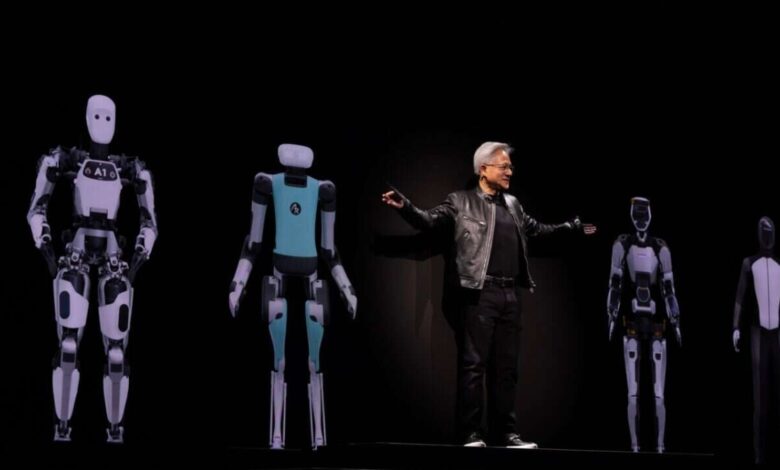‘This is not science fiction’: NVIDIA CEO Jensen Huang highlights use of robotics and AI tech ahead of COMPUTEX

NVIDIA’s CEO Jensen Huang highlighted the company’s advancements in robotics and industrial digitisation at COMPUTEX 2024 in Taipei. Huang detailed how manufacturers like Foxconn are using NVIDIA’s technology, such as Omniverse, Isaac, and Metropolis, to develop advanced robotic facilities. “Robotics is here. Physical AI is here. This is not science fiction, and it’s being used all over Taiwan,” Huang said.
Here are the key highlights made by NVIDIA CEO Jensen Huang during his speech:
Accelerated Platforms and AI Factories
NVIDIA has announced that accelerated platforms are now fully operational. From AI PCs powered by NVIDIA RTX to enterprises building AI factories with NVIDIA’s full-stack computing platform, the future of computing is geared towards speed and efficiency. “The future of computing is accelerated,” Huang stated.
New Semiconductor Roadmap
Huang announced a new semiconductor release roadmap on a one-year cycle. NVIDIA plans to introduce the Rubin platform after the upcoming Blackwell platform, featuring advanced GPUs, an Arm-based CPU named Vera, and new networking technologies like NVLink 6. “Our basic philosophy is very simple: build the entire data center scale, disaggregate and sell to you parts on a one-year rhythm, and push everything to technology limits,” Huang explained.
Sustainable Computing
NVIDIA is focusing on sustainable computing by combining GPUs and CPUs to achieve up to a 100x speedup with only a threefold increase in power consumption. This results in 25x more performance per watt compared to CPUs alone. “Accelerated computing is sustainable computing,” Huang noted.
Industry Partnerships and AI Factory Collaborations
Taiwanese manufacturers, including ASRock Rack, ASUS, and GIGABYTE, are using NVIDIA GPUs and networking solutions to create advanced AI systems. The NVIDIA MGX modular reference design platform supports these systems, enabling optimal performance in AI applications. AMD and Intel are also supporting the MGX architecture with their own CPU designs.
Next-Generation Networking
Huang revealed plans for annual releases of Spectrum-X products to meet the demand for high-performance Ethernet networking for AI. NVIDIA Spectrum-X, the first Ethernet fabric built for AI, enhances network performance by 1.6x compared to traditional Ethernet fabrics. Early adopters include CoreWeave and GMO Internet Group.
Empowering Developers with NVIDIA NIM
NVIDIA introduced NIM (NVIDIA Inference Microservices) to help the world’s 28 million developers create generative AI applications easily. NIM provides models as optimised containers that can be deployed on various platforms. Partners like Cadence, Cloudera, and Synopsys are integrating NIM to speed up generative AI deployments.
AI-Powered Consumer Devices
NVIDIA’s RTX AI PCs aim to enhance consumer experiences with over 200 RTX AI laptops and more than 500 AI-powered apps and games. The RTX AI Toolkit and new PC-based NIM inference microservices for the NVIDIA ACE digital human platform demonstrate NVIDIA’s commitment to AI accessibility.



